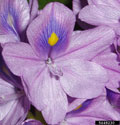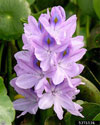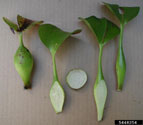Water Hyacinth: Images
Click on the text link under each photo to see a larger picture.

A single flower with the distinctive uppermost petal
Photo credit: Leslie J. Mehrhoff, University of Connecticut, Bugwood.org

Inflorescence of flowers
Photo credit: Vladimir Dinets, University of Miami, Bugwood.org

Morphology of water hyacinth plants
A - the "attenuated-petiole" rosette form produced in crowded conditions;
B - an expanding axillary bud;
C - a developing ramet; and D - the "bulbous-petiole" rosette form produced in open conditions.
Abbreviations: ar - adventitious root; in - inflorescence; is - leaf isthmus; la - leaf blade; pl - primary leaf; pd - peduncle of flower spike; pt - leaf petiole; sp - spathe; st - stolon.
Photo credit: USDA Agricultural Research Service Archive, USDA Agricultural Research Service, Bugwood.org

Cross- and longitudinal-sections through the different shapes of petioles
The "bulbous-petiole" form is on the left and the "attenuated-petiole" form is on the right.
Photo credit: Leslie J. Mehrhoff, University of Connecticut, Bugwood.org

Two water hyacinth rosettes showing the black roots and the connecting stolon.
Photo credit: Leslie J. Mehrhoff, University of Connecticut, Bugwood.org

Water hyacinth plants on a boat trailer, showing one way the species spreads.
Photo credit: Tony Pernas, USDI National Park Service, Bugwood.org

Water hyacinth infestation covering the surface of a lake in Alabama.
Photo credit: Graves Lovell, Alabama Department of Conservation and Natural Resources, Bugwood.org

